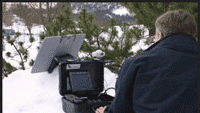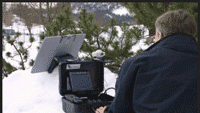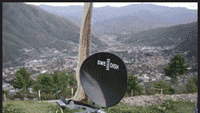Portable news links

In the last 12 years, the technology used for covering news stories has advanced to an almost unimaginable degree, as witnessed in the Iraq conflict. We have seen countless live reports in both high and low quality, depending on the equipment used.

7E’s Talking Head videophone weighs under 5kg and can be used anywhere with clear sight of an Inmarsat satellite.
Yet in some ways, it has not changed much at all. In the Gulf War of 1991, news organizations were hauling 30 to 40 boxes of SNG equipment weighing up to 1500kg, and requiring at least two engineers to rig and operate the uplink. In 2003, many news organizations are still using the same type of SNG equipment, but the difference is that new portable news link equipment is now available.
Store-and-forward units
Store and forward was first used by the BBC to cover the activities of the Taliban in Kabul, Afghanistan, in October 1996. It used a new rugged and compact store-and-forward unit manufactured by Toko of Japan. The unit, when used with an Inmarsat B satphone, enabled journalists to send reports from virtually any location in the world and work unaided in the field without experienced satellite-uplink technicians.
The principle of store and forward is that a video/audio signal is digitally sampled at a high data rate, stored as a file, and then fed at a much lower rate over an Inmarsat “high-speed” data link. A studio receives the signal on a corresponding unit. Once the file is complete, the studio unit can replay the piece in real time for transmission.
Several manufacturers have produced store-and-forward units (now mostly integrated into laptop PCs). But the rapid development of rolling 24-hour news channels across the world has created an increasing appetite for the ability to come “live” from virtually any story. And this appetite has hastened the development of the videophone.
Get the TV Tech Newsletter
The professional video industry's #1 source for news, trends and product and tech information. Sign up below.
Videophones
Inmarsat introduced the GAN sat-phone in 1999 as a replacement for the earlier Inmarsat B satphone. The GAN unit can carry either a speech telephone call or a 64kb/s ISDN call, and the ISDN connectivity allows the user to file a live report through a videophone. Connect two GAN satphones together, and you get a 128kb/s data rate and appreciably better video and audio quality. 7E Communications and the BBC originally conceived the Talking Head videophone in mid-1998 as a way of replacing the traditional library still picture when the studio is doing a live “phoner” with the correspondent in the field. By early 2000, 7E’s first production Talking Head videophone arrived, mating perfectly with the just-launched Inmarsat GAN sat-phone to provide a 2-box solution for live news gathering.
The Inmarsat GAN weighs about 3kg and is the size of a laptop PC, and the Talking Head videophone is about the size of a large lunch box and under 5kg. Both units are battery powered and can be used literally anywhere with clear sight of an Inmarsat satellite. They also have enhanced news-gathering capabilities so that breaking stories can now be covered from situations that previously would not have allowed live TV coverage.
SWE-DISH IPT Suitcase
The latest in compact portable news links is the SWE-DISH IPT Suitcase. The single 35kg unit offers 2Mb/s high-quality video and audio transmission in a small carry-on suitcase-size unit. Its 1-person operation is enhanced by the auto-pointing facility, which means that an expert technician is not required to operate it.

The SWE-DISH IPT Suitcase is a single 35kg unit that offers 2Mb/s high-quality video and audio transmission in a small carry-on suitcase-size unit.
The Suitcase enables journalists to move as quickly as the situation demands, which is not necessarily the case with even a small traditional 90cm flyaway SNG system. Its compactness allows news editors to dispatch several smaller teams to cover different angles of a story. To get on air, you hook up the camera or VTR to the unit and connect to the studio in less than five minutes, assisted by the built-in GPS and compass to acquire the satellite.
Although the initial purchase is more expensive compared with a GAN satphone, the Suitcase is appreciably cheaper to run in terms of airtime compared with 64kb/s service. The cost-per-minute works out proportionally at around one-tenth, so you can recover the initial cost soon.
Jonathan Higgins is managing director of independent UK satellite communications consultancy BeaconSeek Ltd. He is also an acknowledged authority on SNG, and wrote the seminal book on the subject, Satellite Newsgathering (Focal Press). His second book is due out later this year.
